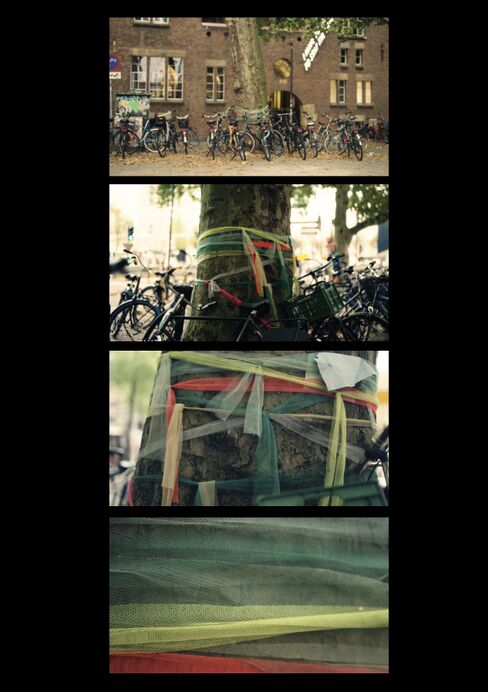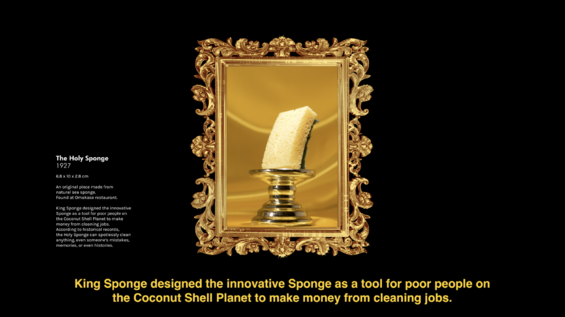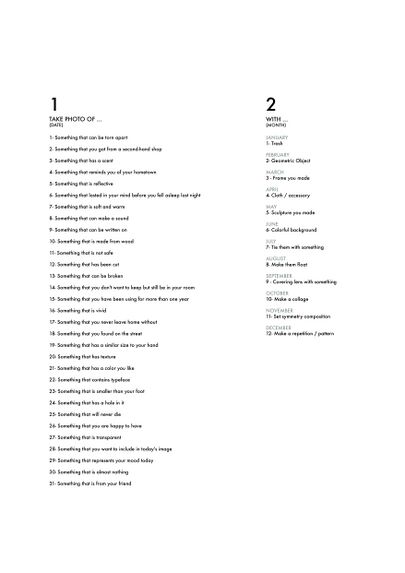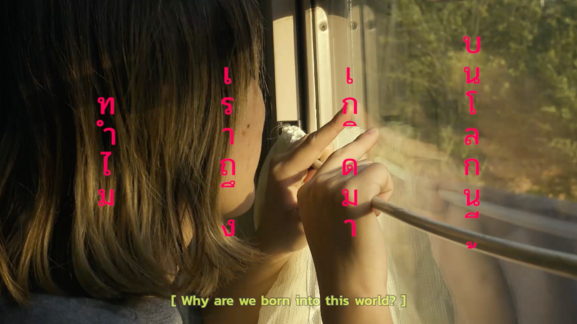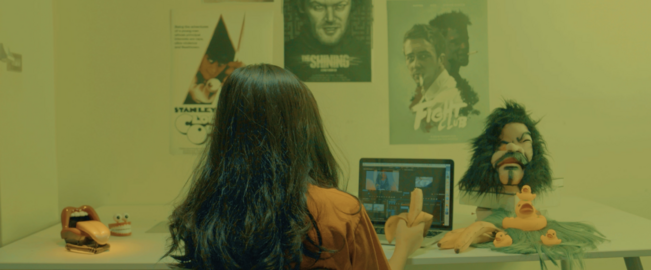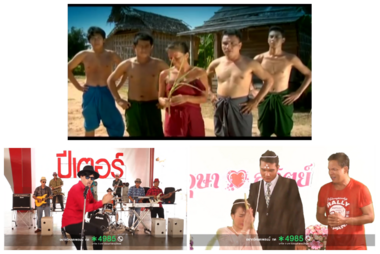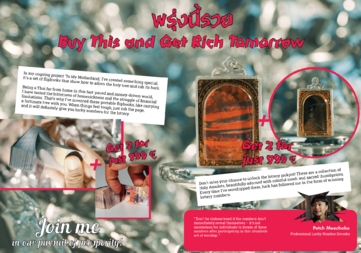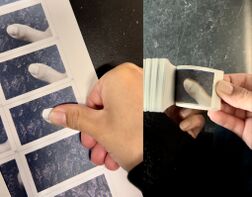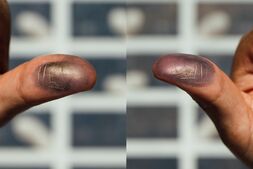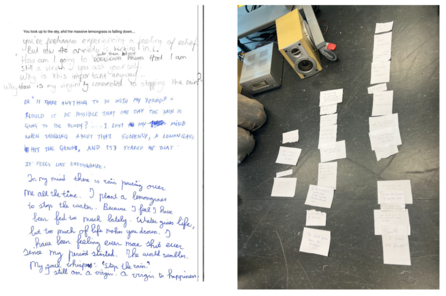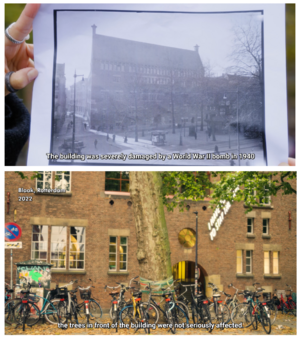Te - Thesis First Chapter: Difference between revisions
Taaaaaaaaeto (talk | contribs) |
Taaaaaaaaeto (talk | contribs) |
||
| Line 255: | Line 255: | ||
In this chapter, I will present a list of well-known Thai superstitious beliefs that Thais are familiar with, along with examples of popular songs that incorporate these beliefs into their lyrics. I will explore how these myths relate to consumerism and capitalism. Additionally, I will discuss some well-known figures from Thai mythology and folk tales that have frequently appeared on television. | In this chapter, I will present a list of well-known Thai superstitious beliefs that Thais are familiar with, along with examples of popular songs that incorporate these beliefs into their lyrics. I will explore how these myths relate to consumerism and capitalism. Additionally, I will discuss some well-known figures from Thai mythology and folk tales that have frequently appeared on television. | ||
=== <u> | === <u>TRY THIS AND GET LUCKY TODAY</u> === | ||
'''FADE IN:''' | '''FADE IN:''' | ||
Revision as of 16:33, 16 February 2024
Te Steve Suggests Transclusion 2 Te Steve Suggests give me luck
GIVE ME LUCK. FEED ME HOPE.
THESIS DRAFT
GIVE ME LUCK. FEED ME HOPE
Thesis submitted to: Piet Zwart Institute, Willem de Kooning Academy, in partial fulfilment of the requirements for the final examination for the degree of: Master of Arts in Fine Art & Design: Lens-Based.
Adviser: Steve Rushton
Second Reader: **
2023-24
Word count: 8258 (First Draft)
Contents:
Introduction
Chapter 1: A Quest for Meaningful Practice
Chapter 2: Haunted Ghosts and a Glimmer of Hope
Chapter 3: Welcome To My Motherland
Conclusion
Introduction
If you want to get lucky numbers for the lottery, rub tree bark with your fingers.
If you want to control the rain, ask the virgin woman to plant the lemongrass upside down to the ground.
If you want to be safe, wear the fortune amulet.
If you want to be unbeatable, get the immortal pattern tattoo.
If you want to offer a beverage to the guardian spirit, it's preferable to use a red-colored drink.
Do not sing in the kitchen if you don’t want to have an old husband.
Do not wear black to visit the patients in the hospital if you don’t want to shorten their time in the world.
Do not cut your nails at night if you don’t want the spirits of your ancestors to rest unpeacefully.
Do not whistle at night if you don’t want to attract or dissatisfy ghosts.
Give Me Luck. Feed Me Hope. is composed of three chapters that seek to deepen my understanding of my practice, the power of media and humor, and the political connotation behind Thailand's deep-rooted superstitious beliefs. In this thesis, I investigate the role of filmmaking through the figure of the unreliable narrator and performative approach, considering how this connects to my fascination with metaphysics and superstitious beliefs. This is a curious fascination, because I am not superstitious in my everyday life. Regarding the graduation project, I am writing about my practice centered around these two main questions. How can I make a film inspired by the myths and media of my homeland while incorporating the context of my current situation in the Netherlands? And how can I visualize the metaphysical idea through symbolic systems in everyday surroundings?
Chapter 1: A Quest for Meaningful Practice
“Haunt signifies both the dwelling-place, the domestic scene and that which invades or disturbs it.” [1]
Here, I will discuss the journey of my practice and theoretical framework. I will reflect on the processes and working methods involved in the works I created before and during this Master's program. I will explain how they have more or less affected my practice in developing my graduation project, Welcome to My Motherland.
Since I was young, I have wondered how far I could go from my hometown, from my family, and from being my current self. I grew up in a typical family in Songkhla, a small city in southern Thailand. Both my parents work for the government and don't know much about the art world. Fortunately, they were open-minded enough to allow me to seek my unknown path. I moved to Bangkok, the central hub of prosperity, to pursue my bachelor's in communication design, just like testing water to see if I should continue. Right after that, I got a job as a junior video editor. Simultaneously, I worked as a freelance photographer. Like many new graduates, I shifted from pursuing art to diving into the commercial world, striving to sustain myself and working hard to produce massive work with a tight deadline for clients who wanted things fast. The first year of full-time work is extremely tough for me, mentally and practically. While I can support myself financially, the income I've earned hasn't always reflected the effort I've invested in this male-dominated industry, mainly due to an unfair social structure. In studying the gender pay gap, Williams (2021, p.3) concluded that “there is no country where women in work collectively earn as much as men for their labour.” I was unsure if I could or felt like growing in this male-dominated industry. I realize this path isn't sustainable for me, as my work doesn’t fulfill me mentally in terms of its value. The question that feels like it requires a lifetime to answer keeps haunting me. “What kind of work or working method do I want to pursue?” “What is my place in the art world?” “What is the meaning of life?” (Well, this one might just be a trick question)
I decided to take a break from the commercial world and give the art world another try. My odyssey began in September last year when I moved from Thailand to the Netherlands for this master’s program. It’s pretty far this time. Predictably, I have traversed great physical and cultural distances. Everything seemed new except the massive tree in front of the school. It would probably not have caught my attention if colored meshes didn’t wrap it.
Though uncertain of the person's intent behind wrapping this mesh around the tree, it immediately reminded me of something familiar in my country.
In Thailand, people believe that it is a symbol indicating that there is a guardian spirit inside. People worship these trees by praying and offering food and beverages to the guardian spirits. I don’t know exactly who is the first person that rubs the tree bark with their fingers. But it is broadly known in my country that the lucky numbers would appear on the bark by doing so —a shortcut to get rich through lottery winnings. This superstition serves as a glimmer of hope, particularly for people in rural areas, offering a chance to secure their livelihoods since government support is inadequate. However, I’ve never personally performed this ritual in Thailand. Still, the idea of trying it here is intriguing, isn't it?
Moving to another country doesn’t erase my Thai roots or what I learned growing up. On the contrary, it makes me realize how deeply ingrained those notions are in me. In a Guardian interview, Thai filmmaker Apichatpong Weerasethakul stated, 'My country is run by superstition.' It sparked my quest to explore superstitious myths and various experiments to connect with my motherland spiritually.
Eventually, it led to the first project that I delved into spiritual myth, The Holy Sponge. It is also the first audio-visual work in which I employ a humorous and sarcastic voice in storytelling.
i. The Holy Sponge (2023)
The Holy Sponge is a 3’47” mockumentary film I made for the Eye Research Labs. It features a fictional exhibition trailer for "Keep Worshipping" at the EYE Filmmuseum. The exhibition highlights the holy qualities of items that the King Sponge owned and used to develop the Coconut Shell Planet. The items shown in the film are influenced by the iconic belongings of the previous King of Thailand released by official Thai media to reflect the King's philosophy of the sufficiency economy. As well as the stories behind them also inspired the script, such as his limited use of twelve pencils per year and his ability to squeeze toothbrush tubes to their fullest potential effectively. To parody the cliché idea of the King of Thailand as a god, I add aspects of the fairy tale and surrealism into the script's narration. For instance, any texts, plans, or wishes written by The Holy pencil will become real, and the Holy Money can automatically duplicate itself at midnight.
The production process involved filming mass-produced banal objects on a shiny silver stand against a moving golden-yellow fabric background, utilizing a high frame rate to achieve a surreal and magnificent effect. The filming approach was intended to blend commercial packshot and exhibition elements to elevate the value of mundane objects.
In the post-production process, the items were edited into golden frames to convey their high value and displayed with museum-style labeling to enhance the exhibition concept. I used particle animation in some shots to create a luxurious feel and added cartoon sound effects to inject a sense of humor. The narration was done by a Thai voiceover using an AI voice generator to create the effect of propaganda and the overwhelming amount of information frequently distributed to the public.
Propaganda, Politics and Attempt to Subvert Power.
As I developed the project, under the theme 'Displacement, Retranslation, and Value Elevation'. The concept of The Holy Sponge sparked when I stumbled upon the cheapest sponges on a supermarket shelf. Their color mirrored the meshes wrapped around a tree. This discovery ignited my recognition of the potential to elevate mundane objects into something exceptional, prompting a shift in my focus toward politics and propaganda.
King Rama IX, the former monarch of Thailand, was depicted as a god-like figure and the father of all Thai citizens. This portrayal was reinforced through official media channels, frequently featuring images of the King's humble possessions and dedication to the country. The purpose of this propaganda was to promote the values of hard work and patriotism. Although the current King has been unable to establish a positive public image since his father's reign almost seven years ago, Thai citizens are still obligated to respect the monarchy and its members. The Thai government has used the Lèse-majesté law, also known as Section 112 of the Thai Criminal Code, as a political weapon to suppress the freedom of speech and expression of Thai citizens. They have jailed many activists for criticizing the monarchy. This mirrors the problematic nature of power in the monarchical state, as Foucault highlighted, "This dysfunction of power was related to a central excess: what might be called the monarchical 'super-power', which identified the right to punish with the personal power of the sovereign." (Foucault, 1995, p80).Despite this happening in Thai society, some hyper-royalists still hold unwavering faith in the monarchy's impartiality, prompting the question, Does it make sense to believe and revere something blindly?
My fascination with the media's ability to manipulate object perception, combined with Marcel Duchamp's notion of 'Readymade' art, which presents mass-produced objects as art,[2] led me to explore the concept of imbuing mundane objects with a sense of holiness, which requires a shift in mindset to appreciate.
If anything could be art, why can't the cheap sponge? I chose the sponge as the primary object due to its symbolic association with low paid labour, and its yellow color corresponded to the Thai King's own iconic palette.
Unfortunately, I was born poor.
Now, I am a kitchen sponge.
My body is soft, porous and yellow, it looks somewhat like cheese. I have 9 siblings from the same pack. Although we share last names, we have different skin colors. Some of us are red, some are blue, and some are green. However, all of us have short and stiff dark green hair. Sometimes, I want to try dying my hair to different colors but I am too busy being used in a human's cleaning job.
I have the ability to absorb (not knowledge but) liquid.
But I wish I could dry myself too.
Everyday, I am soaked in water.
Over 8 hours a day.
So cold that I cannot stop shivering.
I sleep in the same sink again.
It takes the whole night to recover and get dry again.
When the sun comes, I’m soaked again.
People in the kitchen use me to remove stubborn dirt. It always hurts when their rough hands squeeze my body. I get new bruises every day I lose my hair every time they scrape me into dirty pans. Maybe I need to buy vanishing cream and anti-hair fall shampoo.
Unfortunately, I was born poor. I cannot afford any pricey products.
My life is cheap. My siblings and I were sold for less than two euros.
I am hungry. People never feed me, they only force me to work. But thankfully, I can secretly eat leftovers while people rub me on dishes.
I worked until my back got crooked.
I worked until my body was full of bacteria.
I guess I will have to work until the last second of my life.
My lifespan is so short. I experienced being a witness to the death of my siblings.
We, as the working-class kitchen sponges, couldn't access any treatment and we don't have any health insurance.
We don't leave any letters because we cannot write.
We don't have a funeral like people do.
Before I was thrown away.
I wonder what it's like being held gently by rich people's soft hands.
Would rich people feed me with a golden spoon?
Would they tell me a bedtime story and send me to bed?
Would other people respect me if I'm wealthy and live in a rich house?
If yes, would I become more valuable? [3]
This short text embodies shapeshifting into the cheapest sponge on the shelf. This idea was sparked from observing a society that emphasizes maximizing production within tight schedules, where numerous workers endure repression and are forced to work tirelessly despite receiving inadequate compensation.
In my previous project, I solely focused on creating work by experimenting with storytelling methods, which often resulted in working without dialogue or not initiating dialogue by writing the script myself. I lacked the confidence to venture into writing a script or to use my writing as the foundation for video work. This exercise prompted me to use the script as the structure for The Holy Sponge, to create a virtual universe where ordinary groups humbly claim their powers and special abilities.
Fake Exhibition: Unreliable Universe
Oscar Wilde: “Man is least himself when he talks in his own person. Give him a mask, and he will tell you the truth.” [4]
Stories, myths, and folklore passed down from generation to generation create a space that feels like entering another world—a realm that embraces and preserves these enduring notions.
I'm intrigued by the tales that objects carry and how they travel through time. Sometimes, the ordinary becomes fascinating when tied to someone special—like a flattened toothpaste tube or worn-out pencils once owned by King Rama IX, a prosperous monarch known for his economically sufficient lifestyle. Objects gain attention, possibly ending up in museums or media, only because of their famous associations.
I used the concept of a fake exhibition to reflect an imaginary world where mundane objects have unique abilities and lies exist as a form of logic. Inspired by overwhelming propaganda, people are invited linearly into this spatial notion and are restricted from leaving it. Propaganda emerges to substitute the yet-unpleasant reality. In our media-saturated world, we effortlessly become entangled in a web of deceitful narratives.
Within The Holy Sponge, I utilize the unreliable narrator, as theorised by Wayne C. Booth as one of the personas or masks. The narrative perspective is centered around the clown who playfully manipulates the truth and the reader's expectations for entertainment, employing irony, varied meanings, and reversals in narration. The naïf narrator is employed in the script to echo the propaganda theme. This inexperienced narrator sees events solely from their own limited and often ignorant perspective, unreliably conveying a complete or accurate story.
Initially, I wrote an English script for the voiceover due to concerns about the excessive number of text that the audience would have to read on the screen alongside the museum-style labels next to the objects in the frame. I didn't want to burden the audience with additional subtitles. However, in the end, opting for a Thai voiceover with English subtitles proved valuable. I think this approach offered a better linguistic context for the intended message I sought to convey. This piece is set in the context of Thailand's history, but I believe its broader themes, such as propaganda, politics, and censorship, are universal and accessible to audiences with non-Thai backgrounds.
In terms of storytelling within the limited time for development, I experimented with various narratives before settling on the linear narrative with the theme of a museum display, showcasing objects in golden frames repetitively. It serves as a good starting point for me to incorporate elements such as a fantasy theme, the use of metaphysical symbols, and humorous and sarcastic voices to develop a more sophisticated structure for the graduation project.
ii. Something that (2023)
Something that is created by someone who feels a bit anxious and still struggles to understand herself, but she wants to do something fun.
Something that is a year-long series capturing daily photos and videos, resulting in a collection of 365 images that portray everyday moments through lens-based media.
Through this series of still-life images. I transformed everyday objects into my visual diary.
There is always something that I don’t understand, something that needs some time to realize, something that keeps me awake at night, and something that I still want to figure out. I admit I don't have all the answers. Life, and even my own captured images, sometimes elude my understanding.
This project was born as a challenge to myself living in a foreign country for more than one year for the first time. The anxiety of not being productive resurfaced, prompting me to question if I could create the ritual to sustain a year-long creative output.
I have an urge to do something, which leads me to the idea of taking a photo every day for a year. With a background in product photography, where setting up each shot took more than an hour and required numerous props made specifically for the project, only to be discarded afterward, I didn’t want to approach my personal project in the same way. Consequently, I decided not to purchase any new props specifically for this project.
Instead, I explored alternative methods of image-making within defined rules and limitations, challenging the conventional approach of polished commercial photography.
Can we have fun while following the rules?
I use two simple methods to create a daily prompt: asking different people to complete sentences starting with 'Something that...' and showing them objects, then asking for descriptions starting with 'Something that...' Afterwards, I use their responses as daily prompts for my photos. This approach encourages interpretation and diverse perspectives on the objects or concepts presented
Each day, I captured subjects aligned with a monthly theme, drawing inspiration from the game ‘Exquisite Corpse,’ where people take turns adding to a piece of paper without viewing what others have added, which inspired me to abandon complete control over selecting subjects. For instance, one of the rules I follow is to capture a photo of something that I got from a second-hand shop on the second day of each month. In January, I focused on photographing trash, resulting in a photoshoot where I combined an object from a second-hand shop with garbage. By subverting the familiarity of mundane and mass-produced objects, ‘Something That’ invites you to reconsider the ordinary and contemplate our shared human experiences. Pause and reflect on the process behind the images we consume. The project reflects the passage of time and the ever-evolving world we inhabit. Through this journey of relocating space, reinterpreting perceptions, and unraveling the complexities of existence, I aim to gain a better understanding of both my practice and the capitalist world that surrounds me.
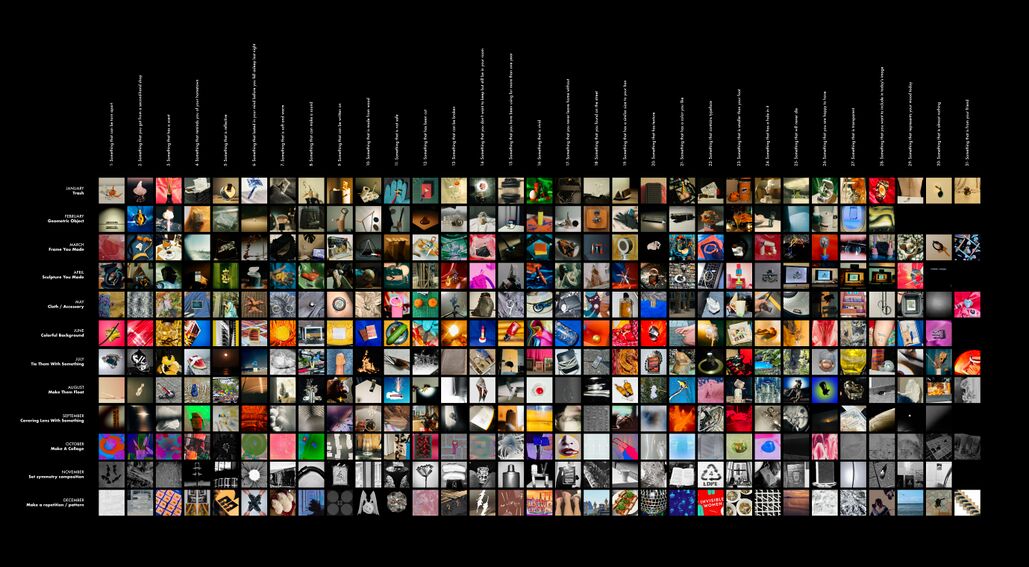
Apart from the 365 photos I've taken for this project, I'm proud of my consistency in taking a daily photo for a whole year. Sticking to the rules and routines I set for myself took a lot of discipline and responsibility. This shows that even ‘something as small as a daily photo’ can lead to ‘something meaningful’ if you stay committed.
iii. Personal Odyssey (2019)
A spiritual quest exists in the inner self; its mystery is intriguing and impossible to unweave.
Personal Odyssey, playing the role of an explorer, wanders through the journey of life.
So you may ask, ‘How does one live through such a journey?’
The answer is simple, ‘By not giving a fuck and living it to the fullest.’
Personal Odyssey is an experimental film with a duration of 5’06”. The film utilized a collage of voiceovers from various people constructed as one storyline presented in an essayistic narrative. It consists of four chapters: 'Why are we born into this world?', 'The flame burning in one’s chest', 'Fuck it', and 'Constantly Changing' which revolve around the existential question of human existence and explore the theme of life's uncertainty and the enigmatic nature of life as the longest journey. The mashup visuals accompanying this narrative depict my expedition along the Trans-Siberian Railway, recognized as the world's longest railway line.
What’s Next?
In late 2017, as a recent graduate from Fine Art school, I found it very challenging to adapt to the commercial world, where fast-paced production is the priority. Even though I learned a lot about technical video aspects from my low-paid first job, it wasn't worth the struggle and mental breakdown I faced. I have many self-doubts and feel desperate to make a living while managing to pursue the work I find meaningful. At some point, I quit that job and used my savings to join two friends on the Trans-Siberian Railway trip. Spending one month and a half on this voyage, covering a total distance of over 9,000 km, creates a mindscape large enough to contemplate the meaning of life, experience the unknown, and explore a deeper understanding of existence.
Mash up Reality.
I collected a handful of footage from the Trans-Siberian trip. I didn’t have a chance to start editing until two years later when I got a better-paid contract job requiring six working days a week as a casting video editor for a reality show. Daily at work, I must listen to each candidate’s struggles and dream-chasing stories through the interviews. As I listened, I found myself wandering through their self-passage toward their quest. I’ve come to realize that life is the longest journey. An expedition full of surprises, doubts, and uncertainties. I resonated with fragments of each candidate's challenges and journey, leading me to embark on my own odyssey of self-discovery. I reconstructed the script by rearranging verbal bits from 13 candidates to reflect my perspective and interpretation of life, which resembles a rollercoaster and constantly changes as one grows up. Once I shaped the storyline, I asked my friends to dub the script due to copyright conditions. I edit the voiceovers with the footage of my path through the Trans-Siberian route to convey the idea of life as the ultimate odyssey.
While working on this project, I became intrigued by the shared memories and social dynamics among the candidates and myself. Additionally, I found the role of the casting video editor particularly fascinating, as it entails the unique privilege of sneaking into the intimate stories of each candidate. Through the interview editing process, one has the power to shape or alter the perception of each person based on the footage they manipulate.
ii. Turning Tide and Cataract (2017)
Turning Tide and Cataract is an 8'41'' long experimental short film. It is my final project for my bachelor's degree and the first short film I have ever made. It's where my passion for unconventional filmmaking started.
Film Editing and Cinematography Techniques
My curiosity about filmmaking began after watching Birdman (2014), directed by Alejandro González Iñárritu. The entire film is seamless, and each scene appears to have no cuts between them. Later, I discovered that some other notable movies, such as Alfred Hitchcock's Rope (1948) and Orson Welles’s Touch of Evil, also use the invisible cut. It prompted me to conduct analytical research on film editing and cinematography techniques derived from those films. After extracting terms from this research, I visualized them through a time-based medium. Subsequently, I analyzed my video works to expand more terms. Employing back-and-forth methods, I explored variable terms before incorporating them into the final film. Eventually, I selected 'Continuity,' 'Disturbance,' and 'Exaggeration' as fundamental filmmaking techniques, pervasive in every movie. Additionally, I created a mind map to document the terms that inspired me as a starting point and expanded upon them.
The film is divided into three parts, exploring the concepts of 'Continuity,' 'Disturbance,' and 'Exaggeration' respectively, in an ironic and subversive manner through the use of various filmmaking techniques, including mise-en-scene, editing, and sound.
It is dialogue-free and follows a senior female student who spends her day editing a project at home, only to be interrupted by a man who pursues and threatens her.
Female Victim Trope
The protagonist in this film was inspired by my experience working on my bachelor's thesis. Initially, she led a mundane life, mirroring my routine. The plot turned mysterious when she discovered a suspicious suitcase at her door. As in many clichéd stories, the innocent female protagonist met her demise at the hands of a mysterious antagonist. It wasn't until I had to analyze my previous work in this master’s program, six years after making this work, that I realized I had employed the idea of the 'female victim trope,' and drew inspiration from numerous American movies where I chose the end for a female protagonist to die by a mysterious man.
I believe one of the reasons is the gender data gap and the absence and inadequacy of female representation in media.
Criado-Perez (2020) said she grew up deeply influenced by the myth portraying women as inferior. This belief stemmed partly from media portrayals of women as consumerist, trivial, and irrational, as well as the significant under-representation of women.
The idea of sticking up for a female character and giving her space on the screen to tell her story or manifest something has been on my mind ever since.
Meta-Cinema
Like The Holy Sponge, Turning Tide and Cataract aims to bridge the gap between reality and fiction and subvert the filmmaking norm with a sense of uncanny. This project is essentially about filmmaking technique and the film often depicted a protagonist editing the footage on an editing software, working on the footage of herself within the same setting we see on the screen. The film utilizes the concept of "meta-cinema" to make the audience aware at some point that they are watching a representation of reality rather than reality itself. By embracing this idea, the audience is invited to question their perception of truth and the influence of the media on it.
Chapter 2: Haunted Ghosts and a Glimmer of Hope
Trailer
“Luck, like everything else, has become a monetised commodity.” [5]
In this chapter, I will present a list of well-known Thai superstitious beliefs that Thais are familiar with, along with examples of popular songs that incorporate these beliefs into their lyrics. I will explore how these myths relate to consumerism and capitalism. Additionally, I will discuss some well-known figures from Thai mythology and folk tales that have frequently appeared on television.
TRY THIS AND GET LUCKY TODAY
FADE IN:
INT. FRONT DOOR – HOUSE – DAY
I walk to the white front door, grab the shiny stainless steel door knob and step out of my home with my left leg. Not stepping out with my right leg yet, I was startled by the greeting of a house gecko. I stand stiff for three seconds after sighing and stepping back into my house.
I remove my shoes and walk to the living room instead of going out.
Come closer. Let me tell you a story about the house gecko. It is a common belief in Thailand that if a house gecko greets you at the door just before you leave home, it's a sign you need to rethink your plans to go out.
Do not leave your house when a house gecko greets you if you don’t want to get into trouble.
BEGIN FLASHBACK:
Maybe you don’t believe in any superstition. Me neither, not until I stepped out of my room after hearing a soft chirping sound from a house gecko.
On that day, I had to move into a long-term house after subletting a temporary room in Rotterdam for almost two months. On the way to my new home, I got into a bike accident in front of our school, and a scar on my knee is still visible and itchy ever since.
Moving from one place to another can be risky. Imagine being a sailor on the open ocean, surrounded by deep, mysterious waters. How would you feel?
As I sat on my new couch sipping hot green tea, a memory of a chirping gecko- a warning I had completely ignored- flooded my mind.
So, next time, checking for chirping sounds before leaving my house shouldn't be much trouble.
BEGIN FLASHBACK.
I return to the same couch and think of something Thais will check before leaving home.
Do not leave your house if a bird has pooped on your head if you don’t want to receive bad news from your close ones.
If you want your business to run smoothly, step out of the house with your left leg.
INT. LIVING ROOM – HOUSE – DAY
There are also shortcuts to avoid bad things happening.
If you want to be safe, wear the fortune amulet.
There are several Thai songs that touch upon the theme of hoping for wealth and luck, which is quite relevant in contemporary society. One notable example is "Saa-Tuu (Amen!)" by Milli ft. TangBadVoice. This song stands out for its humor and ability to capture the shared feelings and situations in Thailand very well.
It is a hip-hop song released in late 2022. The song starts with uniquely spelled lyrics, intriguingly turning out to be "salmon and potato."
The chorus addresses common issues like financial struggles, unpaid salaries, health concerns, loneliness, and asking, "Can I at least have some luck?"
The post-chorus continues with prayers for employment, wealth, lottery wins, prosperity, a partner, and a wish for a COVID-free and peaceful life.
Later lyrics center on a monk positioning himself as a supernatural force and a bearer of fortune. He sells amulets at the lucky price of 9,999 baht, claiming they can resolve any problem for the buyers. Despite asserting invulnerability, he later fails to withstand harm or a stabbing attempt, ultimately requiring hospitalization. The revelation that the amulet isn’t made of sacred materials but chocolate adds a humorous twist.
The song's ultimate message underscores self-reliance, emphasizing that your efforts will lead to positive outcomes.
Do not walk across books if you don’t want to be stupid.
Do not keep a broken comb if you don’t want bad things to happen.
Do not cut your hair on Wednesday if you don’t want to bring bad luck.
In Buddhism, it is taught that you should treat parents like Divine Teachers.
Do not fight with your parents if you don’t want to become a Pret, a hungry and suffering ghost.
EXT. FIELD – DAY
There is no gecko greeting or bird pooped on the following day. I spot a massive tree with a colorful mesh wrapping around it, which immediately reminds me of this myth.
If you want to get lucky numbers for the lottery, rub tree bark with your fingers.
Zweed n’ Roll’s 28 is a song released in late 2023, centered around the fantasy of winning the lottery and getting rich. The lyrics detail post-lottery aspirations, including fame, TV appearances, quitting a job, buying a house and car, flying first class abroad, and even capturing the dog's meal with a Leica camera. In the music video, a man consults a medium about dream interpretation and number decoding, with the medium suggesting lucky numbers. Ironically, he doesn't win, and the twist unfolds as the sarcastic medium claims the substantial prize from his dream. The video concludes with the man going to bed, ready to indulge in pipe dreams once again.
Unfortunately, after walking out without an umbrella for a while, it seems like it’s about to rain. I am looking for a virgin woman, but I only see men walking around that area. Why this world is full of men? And they always seem to be oppressive and useless in this situation.
If you want to stop the rain, ask the virgin woman to plant the lemongrass upside down to the ground.
This notion is widely recognized and even serves as the basis for songwriting. Several songs are based on this myth. For instance, Pak Ta Krai by Buddha Bless and Peter Toplines share the same title. The title refers to the ritual of planting lemongrass upside down to stop the rain.
Buddha Bless's music video Pak Ta Krai is set in an ancient period in Thailand and begins with a storm approaching, indicating heavy rain. The male vocal starts with the lyrics, "Who planted the lemongrass upside down to the ground?" A woman holds lemongrass, glancing awkwardly at men behind her before tossing it and fleeing. Chased by the men, the second lyrics state, "You shouldn't do it if you aren't a virgin."
Both songs and their music videos center around the quest for a woman to undertake the ritual of planting lemongrass upside down to the ground, which Thais believe can stop the rain if the performer is a virgin. Many women ran away as they knew they were not qualified and didn’t want to be blamed for the potential consequences.
Buddha Bless's Pak Ta Krai concludes by emphasizing that rain is a natural phenomenon beyond human control. However, it still underscores the value of preserving virginity, considering it a precious gift from parents.
Peter Toplines’s Pak Ta Krai music video features several female dancers performing suggestive dance moves with the only male singer in the center. Additionally, it reinforces the notion that women should maintain their virginity until marriage
Drawing from my experience seven years ago as a camera crew during an outdoor production shoot, Thai crews employed this ritual to prevent rain from damaging their expensive, non-waterproof equipment while shooting music videos.
Some women were required to do extra work without receiving any additional payment. How ironic that only one gender is qualified for this job but isn't compensated, yet they're blamed if the results aren't satisfactory. This situation is extraordinary, but the same applies to household chores and other tasks.
In studying the gender data bias, Criado-Perez (2020, p.70) informs us that “globally, 75% of unpaid work is done by women, who spend between three and six hours per day on it compared to men's average of thirty minutes to two hours.”
Luckily, it hasn’t rained for so long. I don’t know who stopped the rain.
I gaze up at the sky. As always, there's a stunning, colossal rainbow after the rain, just like this time. Although I'm curious about what it would be like to point it out to others, I keep my fingers tucked into my jacket.
Do not point at the rainbow if you don’t want to end up fingerless.
On the way to the hospital, I observe a man removing his amulet before gathering his and his wife's clothes hanging on the clothesline.
Do not walk under the clothesline while wearing the amulet if you don’t want to diminish its power or effectiveness.
INT. HOSPITAL – DAY
I stand in front of the hospital mirror, double-checking that I'm not wearing any black clothes.
Do not wear black to visit the patients in the hospital if you don’t want to shorten their time in the world.
Do not call newborn babies cute if you don’t want to make ghosts jealous and cause them to kidnap the babies.
EXT. TEMPLE – DAY
There are essential rules to follow when inside the temple
If you want to offer a beverage to the guardian spirit, using a red-colored drink is preferable.
Do not look down between your legs when attending a funeral if you don’t want to see ghosts.
Various female characters in Thai literature and myth appear in TV shows including Nang Wanthong from Khun Chang Khun Phaen, who is infamous for having two husbands, and Kaewmanee from Kaew Na Mah (the Horse-Faced Princess), who cursed with a literal horse face, she falls in love with Prince Phra Pinthong, who initially rejects her due to her appearance. He sets several conditions for marriage, but ultimately, she fulfills them all, breaking the curse and restoring her beautiful face. They live happily ever after.
One of the most famous is Mae Nak, a Thai ghost known for over a century, which is featured in numerous historical records. Some believe she might have actually existed.
Philip Cornwel-Smith provides a brief story of Mae Nak in his book "Very Thai: Everyday Popular Culture." According to him, “Mae Nak died in childbirth while her husband Maak was at war. Mother and baby initially appeared normal on his return, only to turn vicious when exposed as specters. In what some see as a moral about Buddhism overcoming both craving and the animist impulse to offer sacrifices, Nak was reconciled to her loss through exorcism by the famous monk Luang Phor Toh. He trapped her spirit in an earthen pot wrapped in sacred cloth and submerged it in a canal, but her story lived on.” (Cornwel-Smith, 2013, p. 217)
I remember learning about this myth after watching the movie Mae Nak when I was little. I used to be terrified to look down through my legs, because of a scary scene in the movie.
Do not attend a funeral while pregnant if you don’t want your baby to be born weak with disabilities.
But you really need to be more careful if you have a womb and are on period.
Do not pick flowers to offer to the Buddha at the temple during your period if you want the tree from which you picked the flower to die quickly.
And even worse, you are probably not allowed to enter this sacred area.
Do not enter the temple during your period if you want to avoid unfortunate events.
INT. KITCHEN – HOUSE – DAY
Do not sing in the kitchen if you don’t want to have an old husband.
Do not lie down while eating if you don’t want to be born as a snake in your next life.
Do not tap a plate if you don’t wish to share your meal with ghosts.
INT. TATTOO SHOP – DAY
There are various patterns for Yantra tattooing or Sak Yant, each with its specific meaning. For example, some are for wealth, while others are for luck in love. However, the most famous is for protection from danger.
If you want to be unbeatable, get the immortal pattern tattoo.
INT. HOUSE – NIGHT
And, of course, there are things to avoid when it gets dark.
Do not respond to an unknown voice calling you at night if you don’t want to invite the strange spirit to your house.
Do not whistle at night if you don’t want to attract or dissatisfy ghosts.
Do not cut your nails at night if you don’t want the spirits of your ancestors to rest unpeacefully.
Do not sweep your house at night if you don’t want to remove the money energy from your home.
INT. BEDROOM – HOUSE – NIGHT
Do not sleep with your head facing west if you don’t want to have nightmares.
Do not have sex on Buddhist holy days if you don't want to discover your guardian angel to have less power.
EXT. TRANCE – DAY / NIGHT
Never underestimate your dreams, they can also give you some hints.
If you dream of a snake, you will meet your soulmate.
If you dream of your teeth falling out, there is a possibility that your relative will pass away.
If you dream of seeing a gecko, you will receive good news from work.
If you dream of a tiger, you will have political power.
If you dream of an elephant, you will receive blessings from elders.
If you dream of a fish, you will succeed in your professional life.
If you dream of a Buddha or a deity, you will receive good fortune.
INT. ADVERTISING STUDIO – DAY
Those are the guides for your life's convenience. However, if you still struggle or experience rough times while following them, I've created something special that you will need.
Buy This And Get Rich Tomorrow offer fortune amulets and flipbooks that demonstrate how to create and obtain lucky numbers from The Holy Tree.
Being a Thai living far from home in this fast-paced and money-driven world, I have tasted the bitterness of homesickness and the struggle of financial limitations. That's why I've invented these portable flipbooks and amulet, like carrying a fortunate tree with you. When things feel tough, just wear amulet and rub the flipbook’s page. Its guaranteed to give you lucky numbers for the lottery and bring luck for the rest of the day.
Get both of them for only 999 euros.
Join me in our pursuit of prosperity!
FADE OUT
“THE END”
Chapter 3: Welcome To My Motherland
Welcome to my logbook, where you will find documentation of the experiments I conducted, the choices I made, and the process of developing my graduation project, Welcome To My Motherland.
Proposition
Welcome to My Motherland is a project that consists of video work, a set of photos, and object installation.
Video work will investigate Thailand's deep-rooted superstitions and rituals, using them as a foundation to explore their profound impact on social issues such as inequality, capitalism, and sexism. This exploration is conducted through a performative approach and a satirical and humorous voice.
The video is expected to be approximately 15-20 minutes long. It will utilize two real myths and one I invented as the basis for the narrative.
The first myth revolves around the mystical concept of the holy tree, where people believe a guardian spirit resides. They also believe that rubbing the tree bark with your fingers can reveal lucky numbers in winning the lottery.
The second myth involves the practice of planting lemongrass upside down in the ground, a belief associated with the power to stop the rain, often requiring the performer to be a virgin woman.
The last myth, which I have invented, suggests that women can be reborn into a world where they hold more privilege over men in their next lives while cleaning a pile of dishes with a holy sponge at midnight.
Additionally, I aim to create a publication that catalogs a set of still-life photos where each image visually represents a specific superstitious belief in Thailand.
In terms of installation, I plan to set up a booth to display and sell physical objects, such as customized amulets, flipbooks, and a publication, alongside the video screenings to create a more immersive experience.
Experiments
April - September 2023
After finishing The Holy Sponge, I had two directions that I wanted to develop. The first was to create work by analyzing propaganda films from Thailand using a methodology similar to what I used in Turning Tide and Cataract (2017). I did visual and sound experiments regarding echos and repetition in the Room for Sound residency. According to the sensitive censorship of Thailand, it seems risky and uncomfortable to dig deeper in this direction. At that point, I decided to continue my self-directed research with the second option, which was about Thailand’s superstitious beliefs.
June - July 2023
“Buy This And Get Rich Tomorrow” is a common saying to encourage people to take a risk in the lottery. Every day before the lottery results are announced, this saying can be found on every lottery shelf.
I borrowed this phrase to use as a project title for the spiritual product I made.
I first tried to make a portable flipbook showing how to wrap a tree with colorful mesh and let you feel the rough bark. They are made using a Risograph technique.
Imagine holding one of these flipbooks in your hands. You're curious, so you gently rub the pages. As you do, the ink sticks to your fingers, revealing a hidden lucky number. It's like uncovering a secret treasure, making the experience not only interactive but also deepening your connection with the artwork.
(This magic only happens in the early days after printing, before the ink fully sets on the paper, so you need to be quick)
An amulet symbolizes luck and is a clear example of a belief that has been commercialized, as it has been available for sale for several years.
I placed my prints in the amulet frame and customized them into earrings instead of the typical necklace. I aim to experiment by infusing a sense of uncanny fashion into the accessory.
September 2023
In the screening at Worm[6], I present a mockumentary video divided into two parts with different narratives. The first part is about The Holy Tree, where I employed a 'performative approach' within the documentary convention. I tried to mock the traditional documentary technique by conducting a self-interview as a professional lucky number decoder. I also insert Lucky Amulet and News footage ads in the storytelling. In the second part, I juxtaposed my footage with the music videos of Pak Ta Krai from Buddha Bless and Peter Toplines. Both of the songs are sung by male artists, and the music video is also about seeking a virgin woman who is qualified to do this performance. I got technical feedback that the editing pace is too fast for non-Thai speakers, and my position on this narrative is still not clear. I need to seek a way to contextualize it.
October 2023
I experimented with freewriting and collective writing to form stories based on superstitious beliefs during mentor group sessions, using the notion of an unreliable narrator to construct the stories. I plan to utilize this fragment in the future for story building, as I intend to create a story based on some parts of the collective writing I experimented with.
Feedback on videos from tutorials and mentor group sessions is quite similar. The use of footage of poor people in the video is almost cynical. I need more character build-up, and contextualizing the video. While my current approach has humor and sarcasm, my improvement plan involves offering a more intensive background and context to enrich the depth of the storytelling.
November 2023
I found archive footage and photos of the bank building (the current WdKA building) with trees in front of it. To make my narrative valid, I wove the true historical archive photo of the bank building into my fictional story. This is considered successful in building a connection through material and stories.
December 2023
This is the month of gathering more materials. During the winter break, I returned to Thailand to gather more footage of the holy tree there, asked my friend to rerecord the V.O., and experimented with a collage technique and Karaoke animation. Moreover, I did a still-life photo shoot to represent a specific superstitious belief in Thailand visually.
I still need to work on contextualizing in a broader context.
January 2024
Initially, I plan to make a series of mockumentaries. However, after the assessment, the tutors thought there are better approaches than describing the work using traditional film terms. They believe my work is about turning metaphysical ideas into something physical. So, it is better not to stick to the term "mockumentary," as it might not fit perfectly. Open up to other possibilities, and don’t have to follow a traditional filmmaking approach, as my work mixes real and made-up myths. Try to clarify my practice by simplifying it.
I decided not to make three episodes of Mockumentary but to develop one video based on those superstitious beliefs.
Regarding a set of photos, I am still working on how to present them.
I printed them out and showed them to tutors and peers. They tried to sort the photos into categories by their appearance, such as magazine covers, altars, etc.
During IFFR 2024, I had the opportunity to watch Crazy Lotus, a short film by Thai filmmaker Naween Noppakun. The film portrays a fantasy world where glasses, a new invention, trigger mysterious occurrences as people see and navigate endless possibilities. It constructs an alternate reality where new logic and terminology prevail. Additionally, it satirizes capitalism, featuring propaganda news advertisements promoting this new invention.
This film reminds me of Red Lotus, as both works use the lotus as a central symbol.
Red Lotus is a photo series by Kamonlak Sukchai. The artist invented her own folklore of a virgin whose sex becomes so sinful that she begs to be reborn as a red lotus to serve the Holiness for good. Her practice often involves the collage technique.
Both projects are very inspiring in using symbols and creating your own myth or reality.
February 2024
I moved to develop another video by making a minute prototype video using written material from a free writing workshop I proposed in the mentor group sessions last year. The video is about the attempt to seek a place to plant lemongrass upside down to the ground to stop the rain, as the Dutch land doesn’t let the lemongrass in.
While visiting Art Rotterdam 2024, I came across a large sculpture of female legs in a field, similar to the smaller one I use in my work. Initially, I considered incorporating it into my video. However, after discussions in mentor group sessions, I realized it would be better not to use the sculpture as a primary narrative or subvert it, as it is already an art piece with its own meaning. To help find the narrative, I found it helpful to keep asking myself, "What am I trying to subvert?" This ensures that I stay grounded in reality and avoid getting lost.
Reflection
...
Conclusion
...
Link to Steve's previous transclusions (and references)
Te Steve Suggests Transclusion 2 Te Steve Suggests give me luck
- ↑ (Fisher, 2014, p.125)
- ↑ M.Duchamp The Creative Act, 1957
- ↑ I wrote this piece in response to Laura Huertas Millan's Decoloniality and Film seminar,
- ↑ (quoted in Otway, 2015, p.3).
- ↑ (Cornwel-Smith, 2013, p. 172)
- ↑ Worm is an art center situated at the intersection of culture and art in Rotterdam. My classmates and I organized the "Flying Ideas" short film screening in late September to showcase our work-in-progress and to initiate discussions during the development phase.

